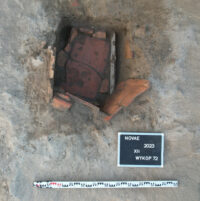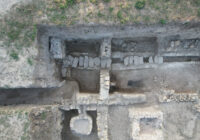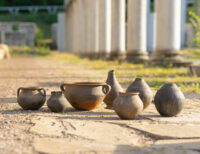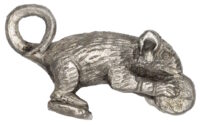 This year’s excavation of the Roman legionary camp of Novae in Bulgaria has uncovered a second Roman refrigeration chamber very similar to the one discovered last year. It too is made of flat ceramic slabs inset in the ground, but this one has an extra feature: a lead water pipe running along its long side to provide additional constant cooling. It is also older, dating to the earliest phase of the camp’s occupation.
This year’s excavation of the Roman legionary camp of Novae in Bulgaria has uncovered a second Roman refrigeration chamber very similar to the one discovered last year. It too is made of flat ceramic slabs inset in the ground, but this one has an extra feature: a lead water pipe running along its long side to provide additional constant cooling. It is also older, dating to the earliest phase of the camp’s occupation.
The Roman castrum (military camp) of Novae was founded in 45 A.D. as a defensive fort on the Lower Danube border of the province of Moesia Inferior. Its builders and first occupants were the soldiers of Legio VIII Augusta. Legio I Italica replaced them in 69 A.D. and settled in for the long-term, only leaving in 441 A.D. when the Huns forcibly showed them the door.
 The refrigeration chamber unearthed in last year’s dig was found under a floor in the stone headquarters of Legio I Italica. This year’s discovery was made in the wood and earth barracks of Legio VIII Augusta, built in the first phase of construction of the camp. The remains of drinking cups, bowls and animal bones were also found inside the Roman fridge. The food remnants will allow researchers to recreate the last meal preserved in the cool chamber.
The refrigeration chamber unearthed in last year’s dig was found under a floor in the stone headquarters of Legio I Italica. This year’s discovery was made in the wood and earth barracks of Legio VIII Augusta, built in the first phase of construction of the camp. The remains of drinking cups, bowls and animal bones were also found inside the Roman fridge. The food remnants will allow researchers to recreate the last meal preserved in the cool chamber.
 Archaeologists also uncovered the earliest known well in Novae and a water network of ceramic and lead pipes. From the later period of occupation, the excavation of a 4th century ceramic furnace revealed a set of intact vessels, including a wine drinking set, in a rare black surface glaze decorated with a smooth finish alternating with concentric circles. These vessels are rare finds on the Danube border, and the chronology of their production is still subject to scholarly debate. The Novae set will be radiocarbon dated to answer some of these long-standing questions.
Archaeologists also uncovered the earliest known well in Novae and a water network of ceramic and lead pipes. From the later period of occupation, the excavation of a 4th century ceramic furnace revealed a set of intact vessels, including a wine drinking set, in a rare black surface glaze decorated with a smooth finish alternating with concentric circles. These vessels are rare finds on the Danube border, and the chronology of their production is still subject to scholarly debate. The Novae set will be radiocarbon dated to answer some of these long-standing questions.
 Injecting a note of whimsy into this year’s extraordinary inventory of finds is a silver mouse. It is a pendant, its tail forming the hanging loop. It is carved in fine detail down to the hairs, and holds a round piece of food (cheese?) in its wee front paws.
Injecting a note of whimsy into this year’s extraordinary inventory of finds is a silver mouse. It is a pendant, its tail forming the hanging loop. It is carved in fine detail down to the hairs, and holds a round piece of food (cheese?) in its wee front paws.
* This article was originally published here












No comments:
Post a Comment